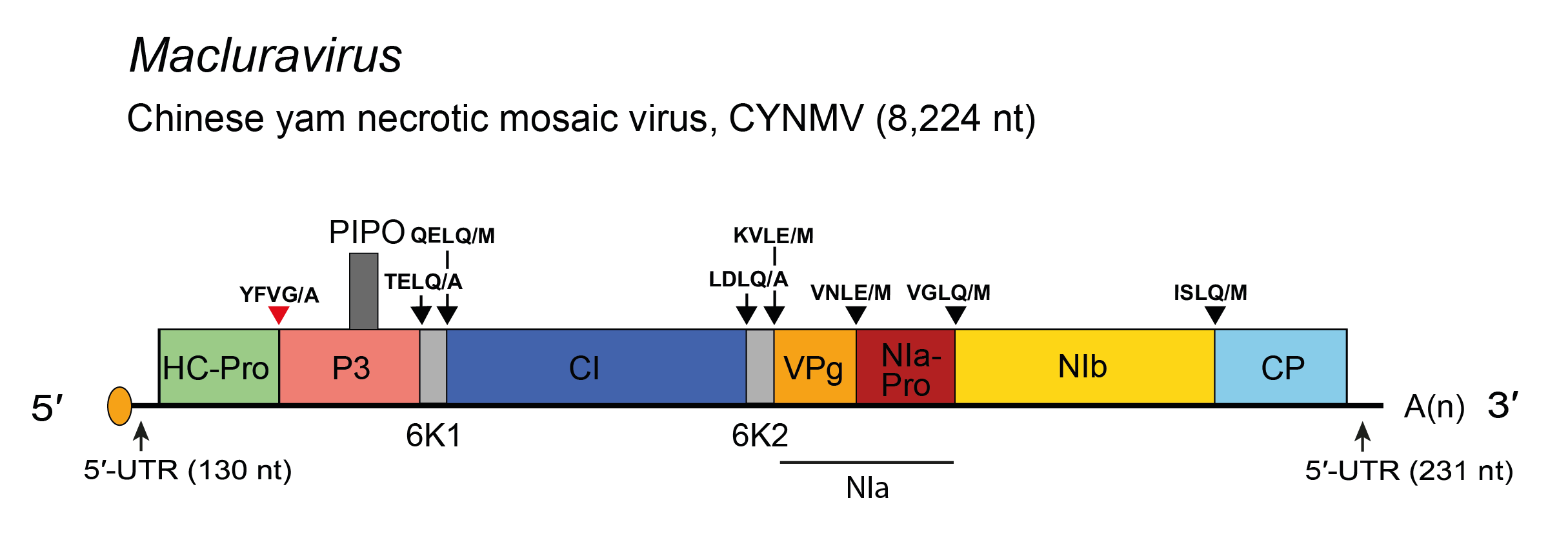Family: Potyviridae
Genus: Macluravirus
Distinguishing features
Macluraviruses resemble members of the genus Potyvirus in their transmission by aphids but virions are slightly shorter. Macluravirus genome structure is distinguished by (1) a shorter genome by the absence of P1 protein-coding region and a shorter HC-Pro; and (2) the absence of the aphid-transmission motif DAG in CP region (Kondo and Fujita 2012). Macluraviruses form a distinct group in phylogenetic analyses and have different polyprotein consensus cleavage sites.
Virion
Morphology
Virions are flexuous filaments mostly 650–675 nm×13–16 nm.
Physicochemical and physical properties
Virion Sedimentation coefficient S20,w is 155–158S; density in CsCl is 1.31–1.33 g cm−3.
Nucleic acid
Virions contain one molecule of linear positive-sense, ssRNA of about 8.0 kb.
Proteins
Macluraviruses have a single coat (capsid) protein (CP) of 33–34 kDa.
Genome organization and replication
The complete genome sequences of eight different macluraviruses are available. The aa sequences of macluravirus CPs show limited (14–23%) identity with CP sequences of some aphid-transmitted potyviruses. Macluraviruses show significant aa sequence identity in portions of the replicase protein with viruses in other genera of the family Potyviridae. The macluraviruses seem to have a genome organization and replication strategy typical of viruses in the family Potyviridae (Figure 2.Potyviridae), except that they lack the P1 coding region (Figure 1.Macluravirus).
 |
| Figure 1.Macluravirus. Schematic diagram of the Chinese yam necrotic mosaic virus (CYNMV) genome. The polyprotein ORF is indicated by the large open box divided into putative mature proteins. The pretty interesting Potyviridae protein (PIPO) is represented by a small box. The untranslated regions (UTR) are represented by lines on each end of the large ORF. Activities of mature proteins are postulated by analogy with genus Potyvirus. Conventions are as for the potyvirus genome organization map (Figure 2.Potyviridae). CYNMV lacks a P1 cistron and has a shorter HC-Pro cistron than most potyviruses. Not to scale. |
Biology
Host range
Current information suggests that most viruses have a narrow host range, infecting species in up to nine host families.
Transmission
The viruses are transmitted by aphids in a non-persistent manner and experimentally by mechanical inoculation.
Antigenicity
Moderately immunogenic. No serological relationships to members of the genus Potyvirus have been found except for a weak reaction between maclura mosaic virus and bean yellow mosaic virus.
Species demarcation criteria
See discussion under family description.

